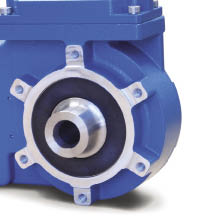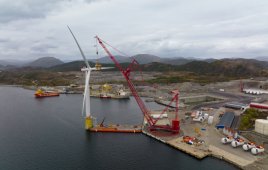It turns out that high vibration and temperature extremes kill even “heavy duty” optical encoders. So to handle such loads, encoder manufacturers have designed units just for wind turbines.
There are three or four basic applications for encoders on the wind turbine, depending on turbine design:
Blade pitch, which controls the amount of wind each blade can harvest
Slip rings, which inform the control system of the rotational position of the blades
Generator control, for synchronization of the generator to line voltage, and
Yaw control, which lets the turbine face into the wind.
Generator feedback and blade-pitch-control applications are considered mission critical. If either of these feedback applications fails, the turbine cannot produce power and can even be destroyed in high winds. It is essential to use reliable components because wind turbines are sited in areas with large temperature fluctuations. In addition, many wind turbines are headed offshore, so their components must be reliable, otherwise servicing and maintenance costs can spiral out of control. The two basic types of encoders (incremental and absolute) use one of two basic types of sensing systems: optical or magnetic.
Incremental encoders provide a square wave output typically the same voltage as the input (5 to 30 Vdc). These are further identified in terms of pulses per revolution (ppr). A common incremental resolution is 1,024 ppr. So for every complete rotation the encoder produces 1,024 pulses. Another common resolution is 2,048 ppr although incremental encoders come in resolutions from 1 to 80,000 ppr. Most wind-turbine applications will be 1,024 ppr. Some OEMs, however, expect 3,072 ppr on the generator. A controller counts the number of pulses to know a shaft’s position and measure the pulses over time to determine velocity.
Absolute encoders are a bit different. Their output data is relative to their position. They output a unique digital “word” for each individual position. They also output in several different field-bus-communication protocols. Instead of using pulses-per-revolution to describe their resolution, they use bits. So an absolute encoder may have an output described as 13 bits instead of 8,192 counts or pulses, and it may use additional bits to describe the number of entire turns, such as 12 bits for a maximum of 4,096 turns. A common application is inside the turbine hub on pitch control units. Encoders are mounted behind pitch motors and brakes or directly engage the blade crown gear. Shafted encoders are picked for these applications as well as hollow-shaft devices.
Of the recent encoders, one version for generators is intended for harsh conditions. It features optical ASIC and encapsulation technologies for long-term resistance to dust, water, heat, mechanical shock, vibration, and more. Features include a phased array sensor for reliable signal output, wide-spaced oversized bearings, an unbreakable code disc (up to 5,000 ppr), an improved seal for increased moisture resistance, an extended temperature range of -40° to +100°C, and IP67 enclosure rating.
Magnetic encoders are available in both incremental and absolute styles. They are hermetically sealed, heavy-duty devices said to detect wear and maintenance issues. One line of these can mount to generator shafts up to 740-mm dia., yet has only a 27-mm profile. These encoders provide 17-bit, single-turn resolution for accurate speed, rotation, and position data even at low turning speeds.
In nutshell, encoder problems have defined their trends. Most often, those problems have been optical system and bearing failures caused by the frequent temperature cycling and fierce vibration on the turbine.
Vibration is just endemic to rotating machinery. Land-based equipment can be bolted to large inertia bases to quell a rotating machine’s vibration. Not so in a nacelle perched atop a 200-ft tower where weight, even though many tons, is a minimum. As the equipment vibrates, mechanical connections fatigue. Combine the vibration with temperature cycling that causes seal failures and a lot of equipment, inexpensive encoders among them, gets shaken into early retirement.
An important element to keep in mind when selecting encoders for these applications is the temperature spec. It’s not surprising that encoders sandwiched between motors and brakes get hot, so make sure the selected device can tolerate the heat. WPE
Filed Under: Encoders, Featured






Wind turbines require reliable transmission of power and data signals from the nacelle to the control system for the rotary blades
more information:http://www.moflon.com